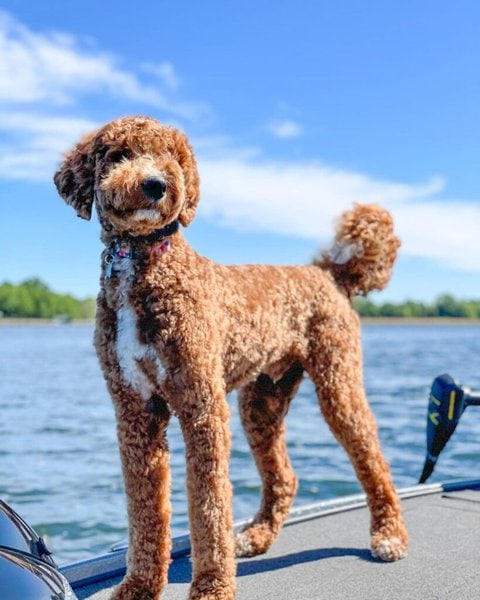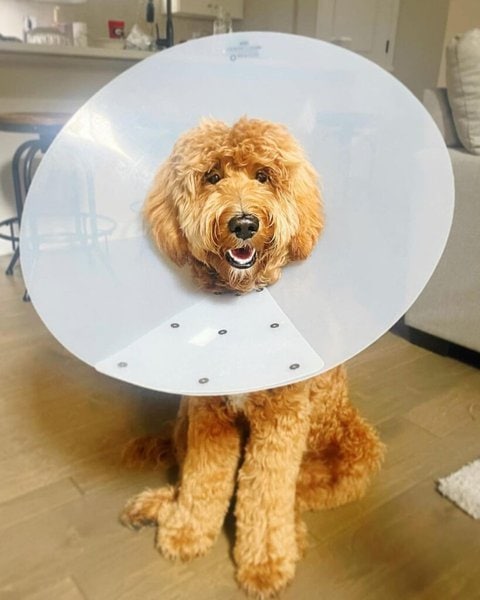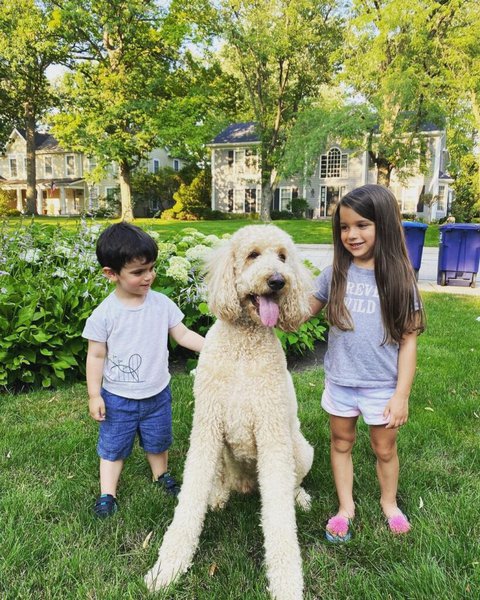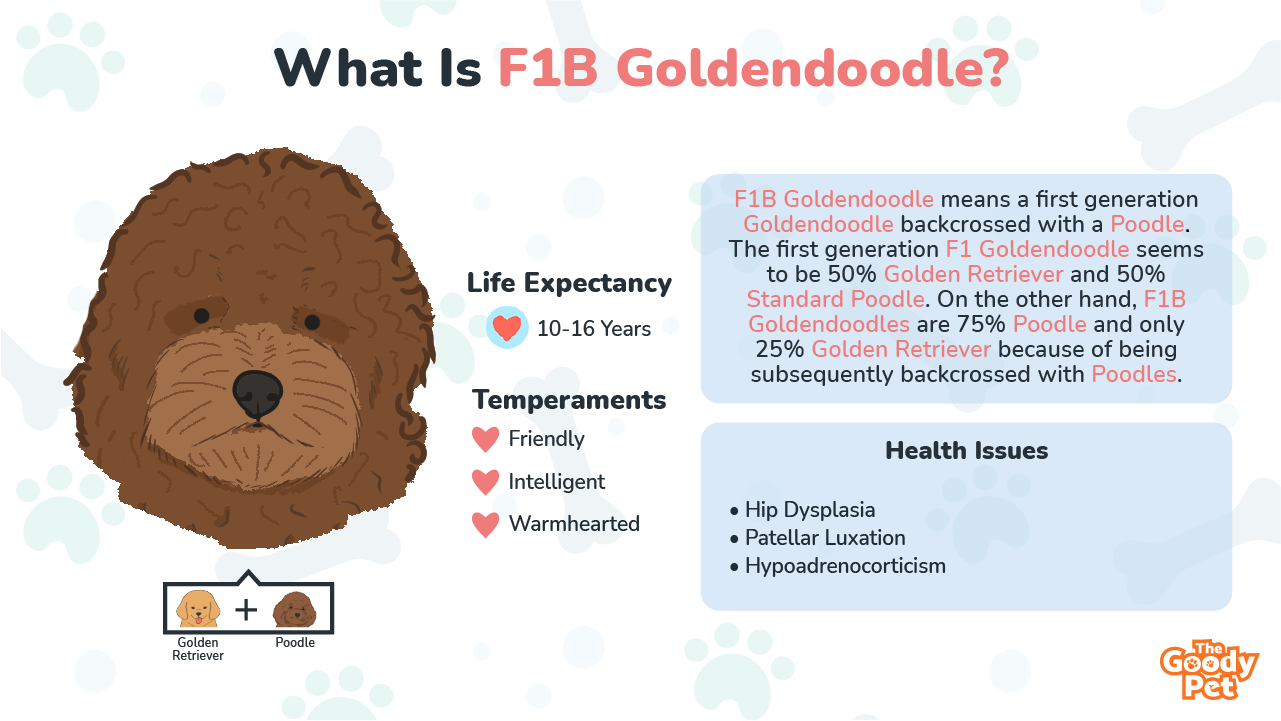How wonderful this fact has been that you can get a pooch with your personal favorite characteristics in it. This is genuinely a great thing for people suffering from allergies who seem to possess a die-heart love for dogs, however, cannot bring one because of messy shedding. F1B Goldendoodle will be a golden breed for such people!
How do F1B Goldendoodles come into existence? When a purebred Standard Poodle crossbreeds a Golden Retriever, you get an F1 Goldendoodle. With this Goldendoodle, when backcrossed with a purebred Poodle, you will get a breed named F1B Goldendoodle.
There is a complete guide to this breed further on. Going down, you will get to know things pet parents seem eager to know as well as things a breed-choosing guy would be looking for. But before going into depth, I would love to introduce the looks of these F1B Goldendoodles. Let’s see if that is as unique as their name!
What Do F1B Goldendoodles Look Like?
An F1B Goldendoodle purely looks like a living teddy bear dog with a slight brown curly hair coat.
What Does F1B Goldendoodle Mean?
The technical letters ‘F’, ‘1’, and ‘B’ from the breed F1B Goldendoodle can be defined this way:
- ‘F’ means filial (offspring or generation).
- ‘1’ is an ordinal number that refers to the 1st position.
- ‘B’ is for the word ‘backcross,’ which means breeding a hybrid (crossbreed) again with one of its purebred parents.
So summing up all this, F1B Goldendoodle means a first generation Goldendoodle backcrossed with a Poodle. However, the backcrossing breed should not necessarily be a Standard Poodle this time, Toy Poodles or Miniature Poodles have also been bred in order to get a wide range of varieties.
Here is a short and easy recap to make things clearer!
- Breeding a Golden Retriever and a Standard Poodle gives F1 Goldendoodle.
- Breeding a F1 Goldendoodle and a Poodle (Standard, Miniature, or Toy) gives F1B Goldendoodle (Standard, Miniature, or Toy).
- Subsequent breeding of the F1B Goldendoodle with a F1 Goldendoodle gives F2B Goldendoodle.
The Basic Difference Between F1 And F1b Goldendoodles
The first generation F1 Goldendoodle seems to be 50% Golden Retriever and 50% Standard Poodle. On the other hand, F1B Goldendoodles are 75% Poodle and only 25% Golden Retriever because of being subsequently backcrossed with Poodles. This makes these pooches highly hypoallergenic, as well as non-shedding.
Size Of F1B Goldendoodles
The size and weight of both Golden Retrievers and Poodles will range between 15 to 24 inches and 44 to 74 lbs. With that being said, an F1B Goldendoodle can easily grow as big as 13 to 21 inches, whereas their weight can be estimated to be around 16 to 30 lbs. This can even be heavier, depending on the size of the Poodle parent.
Physical Appearance
Golden Retrievers come up in a few shades of golden color only, i.e. light golden, dark golden, or a simple bright golden. While in Poodles, you will find attractive colors like apricot, cream, black, gray, white, and brown.
Mixing such a wide range of colors from the two breeds, F1B Goldendoodles most likely appear in colors like gray, cream, black, or mostly in any of the wide range of brown and red shades.
F1B Goldendoodles inherit the coat color mostly from Golden Retrievers, while the curly and non-shedding coat characteristic comes from their Poodle parent.

How Long Do F1B Goldendoodles Live?
F1B Goldendoodles have a lifespan of around 10 to 16 years.
Despite not facing major health issues and being widely regarded to be one of the healthy crossbreeds, there are still a few common health problems F1B Goldendoodles generally inherit from Golden Retrievers or Poodles.
Hip Dysplasia
Hip dysplasia, the dislocation of hip joints, is quite common among Golden Retrievers and Poodles, thereby labeling this condition as a purely genetic disease for F1B Goldendoodles.
Because both the crossed and purebred parents commonly face hip dysplasia, their backcrossed offspring, F1B Goldendoodles, will have higher chances of inheriting such genes and suffering from this condition.
Patellar Luxation
This disease is also similar to hip dysplasia, as the knee here gets affected in the same manner. This knee injury is more common among Poodles; hence, F1B Goldendoodles will face higher risks of patellar luxation since their genetic makeup comprises 75% Poodles.
In such cases, your F1B Goldendoodle finds jumping and running a lot harder and painful to perform, however, surgeries and continuous therapies help in tackling the situation.
Progressive Retinal Atrophy And Cataracts
F1B Goldendoodles are prone to eye diseases, like progressive retinal atrophy (PRA) and cataracts. Both Golden Retrievers and Poodles have these common eye problems that lead to damaged retina or lens, blurring the vision these dogs will have. Both diseases progressively lead to day and night vision losses, or sometimes complete and eventual blindness.
Hypoadrenocorticism (Addison’s Disease)
Addison’s disease in F1B Goldendoodles usually originates from the Poodle’s parentage rather than that of the Golden Retriever. In this hormonal disease, the two hormones, namely cortisol, and aldosterone, are produced by the adrenal gland but in amounts deemed to be insufficient for your pooch’s body to function properly.
Owners should get their pooches genetic testing and regular checkups at early ages. This helps to have precautions in place before reaching a point in the time when the disease has taken its toll.

How To Take Care Of Your F1B Goldendoodle?
Healthy Diet
Nutritional requirements in Goldendoodles generally vary from dog to dog, depending on their sizes and activity levels. F1B Goldendoodles, however, generally need to intake 1,200 calories per day.
When it comes to their diet, protein should be the main ingredient, along with moderate amounts of fats and little to no grains. In addition, multivitamins, while reducing the stress level of their body, help to balance other body requirements like energy production and muscle strength.
Grown-up F1B Goldendoodles expect meals twice a day, while puppies tend to eat 3 to 4 times a day. The amount however ranges between 1 to 4 cups, again depending on the size of your F1B Goldendoodle.
Well, F1 Goldendoodles backcrossed with Standard Poodles seem to have higher nutritional requirements due to larger body size. On the other hand, those backcrossed with a Toy or Miniature Poodle will require a lesser amount.
Do consult your vet for the accurate diet of your pooch. You can also explore this Pet Plate to get the meal plan for your F1B Goldendoodle.
Water Intake
Providing 1 ounce of water per pound of the body weight of your F1B Goldendoodle will make it stay well-hydrated every day. Similarly, puppies should drink half a cup of water every 2 hours the entire day.
To keep your pooch’s mouth fresh and clean all the time, you can simply add a few drops of dental water additives in the same water serving.
Regular Exercise
F1B Goldendoodles have inherited the exercise requirements from their ancestors. You’ll find Goldendoodles pretty active and social, and so they require short walks and exercise sessions almost every day.
Walk your F1B Goldendoodle for 20 to 30 minutes every morning. They are eager to please and are easy-to-handle doggies, so you’ll make that time worth it.
Do F1B Goldendoodles Bark A Lot? Temperaments Of F1B Goldendoodles
F1B Goldendoodles are not bred to be guard or service dogs, so they are neither known for aggressive barking, nor having barking tendencies as part of their personality traits.
Friendly
F1B Goldendoodles are well-behaved and calm canines. You will not find anyone disliking these pooches as they seem friendly to every single person. They love children, remain super loyal to family members, and can be seen playing even with cats and strangers too. Anyhow, socialization at an early age is still a must for every dog breed.
Intelligent And Smart
F1B Goldendoodles are smart pooches because of being offspring of intelligent ancestor breeds, i.e. Poodles and Golden Retrievers.
According to neuropsychological researcher Stanley Coren’s books, The Intelligence of Dogs and Born to Bark. Stanley, involving 199 dog-obedience judges, examined 110 dog breeds for their intelligence. Out of which, both Golden Retrievers and Poodles happen to be among the top 5 most intelligent dog breeds.
Because of these inherited intelligence genes, F1B Goldendoodles are found to be super intelligent. They are a lot easier to train as well and don’t normally require additional obedience training.
Warmhearted
F1B Goldendoodles can be a perfect breed for first-time owners because of their non-aggressive and loving nature. They are eager to please, sweet, kind, and gentle, and thus can be truly declared as “family pets”.
You can also leave your F1B Goldendoodles alone at home while running errands or getting some work done away from home, but it would be best if they have their toys or favorite TV channel to keep them occupied in your absence. Puppies, on the other hand, shouldn’t be left home alone for more than a few hours.

Are F1B Goldendoodles High Maintenance? Grooming Tips For F1B Goldendoodles
Having 75% Poodles in their genetic makeup, F1B Goldendoodles are considerably hypoallergenic. This technically means that they won’t require very frequent grooming sessions and will be regarded to be low-maintenance pooches.
However, some level of grooming is still required, not because of their shedding but because of how curly their coats will become as time passes. Still, you won’t need to vacuum your house to get rid of furs, what else better a pet owner could wish for than this!
Here are some important grooming tips for your F1B Goldendoodle.
Haircuts
F1B Goldendoodles are not exactly high-maintenance canines and will only need a professional haircut once every 2 to 3 months, depending on the haircut length you tend to keep on your pooch.
Daily Brushing
Curly coats of F1B Goldendoodles can save owners from the shedding messes, but the tight curls when tangled, usually leads to irritation or occasional pain. Moreover, messy coats are at a higher risk of getting turned into “fleas house”, causing more skin problems.
To save you from long knot-opening sessions, we recommend brushing F1B Goldendoodle’s coat using this Hertzko Self Cleaning Slicker Brush every morning. This brush is perfect for curly hairs as it removes tangles and mats going deep into the undercoat.
Bath
For F1B Goldendoodles, bathing should be scheduled every three months. Well, you may need to bathe your canine frequently, sometimes depending on how dirty and smelly they tend to get.
Here I will recommend Pro Pet Works All Natural 5 In 1 Oatmeal Shampoo And Conditioner for your Goldendoodle. This will prevent skin itching and oil dryness frequent baths often lead to. In addition, this shampoo de-tangles the matted curly hairs of your F1B Goldendoodle for easy brushing.
Related Questions
Are F1B Goldendoodles More Expensive? F1 Goldendoodles are only 50% Poodle in their genetic makeup, whereas F1B Goldendoodles are 75% Poodle which means, more hypoallergenic and non-shedding than F1. Hence, F1B Goldendoodles can be seen as far more expensive than the other Goldendoodles. An F1B Goldendoodle usually costs around $2,500, while other Goldendoodles cost around $2,000.
Which Is Better F1 Or F1B Goldendoodle? Every generation of the Goldendoodles is unique in its own way and no breed is better than the other. The selection boils down to the owners’ preferences and specified requirements. With that being said, one major difference between the two breeds is the level of shedding. F1B Goldendoodles shed less than F1 and are thus more hypoallergenic. Many owners would prefer F1B Goldendoodles because of this hypoallergenic trait.
Do F1B Goldendoodle Swim? F1B Goldendoodles love water and are swimming enthusiasts. Since both Golden Retrievers and Poodles love to swim, F1B Goldendoodles can quickly get used to a water body, whether it is a lake, beach, or a small swimming pool in your backyard.





